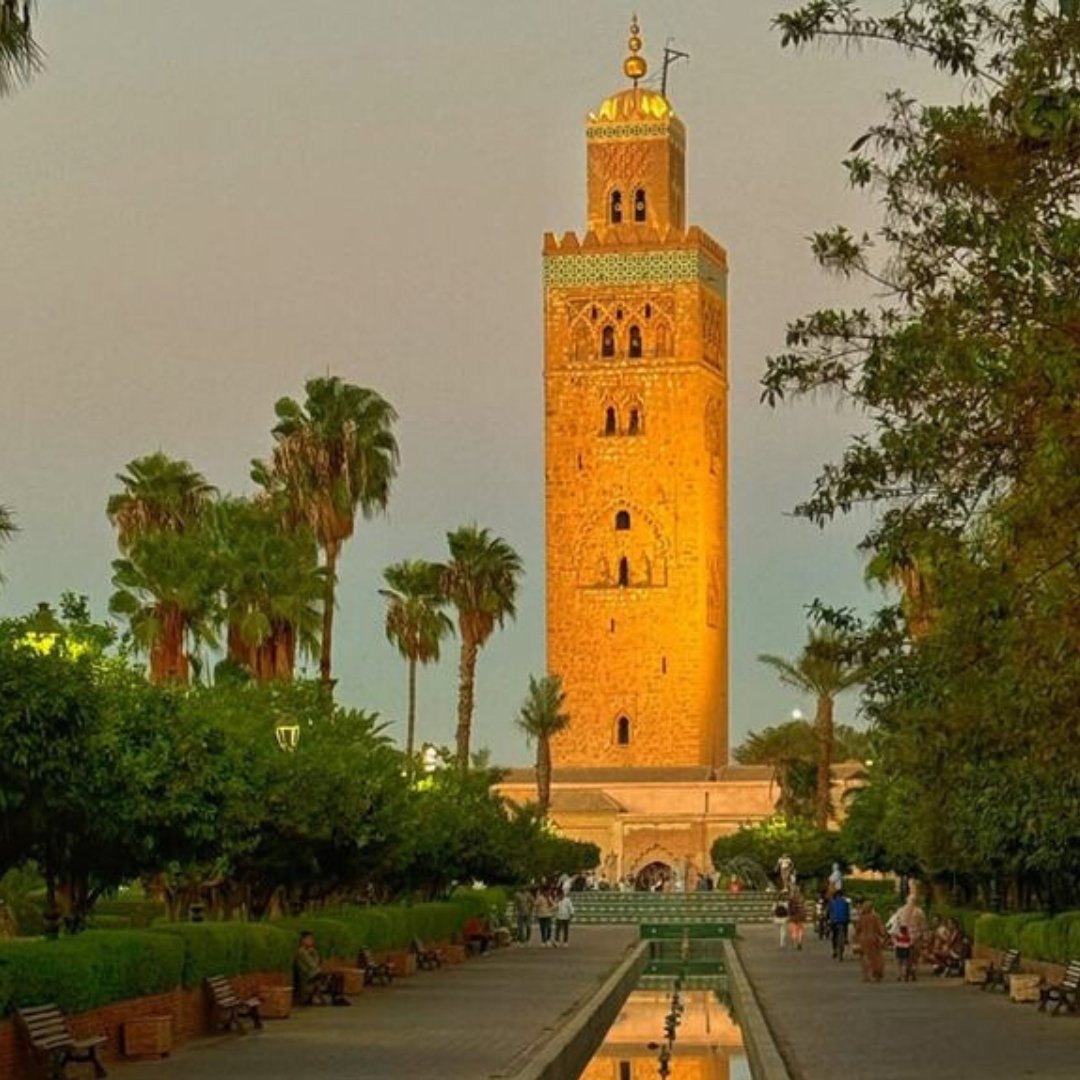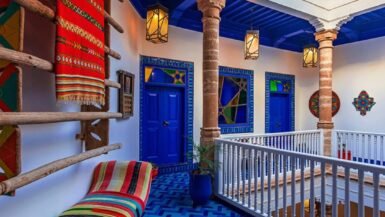The Koutoubia Mosque rises majestically in the heart of Marrakech, with its iconic minaret recognized as the undisputed symbol of the city and its most important monument. This comprehensive guide will take you on a journey exploring the rich history of the Koutoubia, its unique architecture, especially the famous Koutoubia minaret, its strategic location near Jemaa el-Fna Square, as well as practical information about visiting the Koutoubia and the important visiting rules you should know before experiencing this unique historical monument in Marrakech.
History of the Koutoubia Mosque: From Two Mosques to an Icon
The history of the Koutoubia Mosque’s construction dates back to the beginning of the Almohad Dynasty, and witnessed two successive constructions before reaching its current form. This magnificent mosque represents one of the most important religious and architectural monuments of Islamic civilization in North Africa.
Construction of the Koutoubia Mosque During the Almohad Era
Construction of the Koutoubia Mosque began in the mid-12th century, specifically during the reign of Almohad Caliph Abd al-Mumin around 1147 AD. Interestingly, the Almohads built two mosques at the same site, as it was discovered that the first mosque was not precisely oriented toward the Qibla (direction to Mecca), which made it necessary to build a second mosque next to it, perfectly aligned with the Qibla.
Development work on the mosque continued during the reign of Yaqub al-Mansur (1184-1199), who completed construction of the famous minaret that became the symbol of both the mosque and the entire city. Under Almohad rule, the mosque acquired significant religious and political importance, being a center of worship and education in the empire’s capital at that time.
Why Is It Called “Koutoubia”?
The name “Koutoubia” comes from the Arabic word meaning “booksellers.” The mosque acquired this name because the surrounding area housed souks specialized in the sale of manuscripts and books. In the 12th century, this area was an important center of science and culture, where booksellers, scribes, and scholars gathered around the mosque, creating a site of intellectual and cultural exchange.
Architecture of the Koutoubia Mosque: The Art of the Almohad Minaret and Mosque
The architecture of the Koutoubia Mosque, especially its famous minaret, is a notable example of the Almohad architectural style that influenced the region and extended its impact to Andalusia and the entire Maghreb.
The Koutoubia Minaret: Its Design and Height
The Koutoubia minaret is distinguished by its imposing square shape and height of approximately 77 meters (253 feet), including the upper lantern. Built with the distinctive red sandstone of the region, it has a warm color that is particularly brilliant at sunset.
This minaret is considered one of the most important architectural achievements of the Almohad dynasty and became a model that inspired the construction of other famous minarets such as the Hassan Tower in Rabat and the Giralda in Seville, Spain.
Minaret Decorations
The four facades of the minaret feature complex and varied geometric decorations, with each facade showing a unique design. These decorations include:
- Interlaced blind (non-pierced) arches
- Network-type geometric patterns (Sebka decoration)
- Beautiful Islamic calligraphic inscriptions
- Horizontal decorative bands that divide the facade into levels
The decorations become more complex as one ascends toward the top of the minaret, in a unique architectural pattern that combines simplicity and complexity simultaneously.
Internal Ramps
One of the distinctive features of the Koutoubia minaret is that it contains no traditional stairs but internal ramps. This unique system was designed to allow horseback ascent to the top, a feature shared with the Hassan Tower in Rabat and the Giralda in Seville, which were built later following the same pattern.
The Mosque Building
The mosque consists of a large hypostyle (column-style) prayer hall, as well as a spacious courtyard. The Koutoubia Mosque was one of the largest mosques built by the Almohads in their era, capable of accommodating thousands of worshippers.
The Almohad architectural design is characterized by simplicity in general form and complexity in surface decorations, with the use of horseshoe arches characteristic of Moroccan Islamic architecture.
Importance of the Koutoubia Mosque: Religious, Historical and Architectural Symbol
The Koutoubia Mosque has multifaceted importance:
From a religious perspective, it is the largest and most important mosque in Marrakech and continues to be an active place of worship for Muslims to this day.
Historically, it represents one of the main monuments of the powerful Almohad dynasty, reflecting their architectural ambitions and religious authority. It symbolizes the golden age of Marrakech as the capital of a powerful Islamic empire that extended across North Africa and parts of the Iberian Peninsula.
Architecturally, the Koutoubia minaret served as a prototype for other famous minarets in Morocco and Andalusia, such as the Hassan Tower in Rabat and the Giralda in Seville. It is considered a model of Almohad architectural art that combines simplicity and complexity.
As an urban landmark, the minaret constitutes the most famous reference point on Marrakech’s skyline, a symbol of the city used for orientation and navigation.
Due to its exceptional importance, the Koutoubia Mosque has been included as part of the UNESCO World Heritage site “Medina of Marrakech.”
Visiting the Koutoubia Mosque: Practical Guide and Access Rules
The Koutoubia Mosque is one of the essential sites when visiting Marrakech, but it’s important to know its access rules to properly plan your visit.
Mosque Access for Non-Muslims
Important: Entry to the main building of the Koutoubia Mosque (the prayer hall) is restricted to Muslims only. This is a fundamental rule to respect when visiting this religious monument.
However, non-Muslims can walk around the mosque and enjoy the view of the magnificent minaret from the outside, as well as stroll through the surrounding gardens. These areas offer excellent views of the minaret from different angles and are considered the best places to take souvenir photos.
Access for Muslim Worshippers
For Muslims, the Koutoubia Mosque is an active place of worship where the five daily prayers are established. Muslim visitors can enter the mosque to pray while respecting prayer times and mosque etiquette.
Mosque Location and How to Get There
The Koutoubia Mosque is located in the heart of Marrakech, just a few steps west of the famous Jemaa el-Fna Square. It can be easily reached on foot from the square or from surrounding neighborhoods.
Due to the distinctive height of its minaret, the mosque serves as an important landmark for navigating the city, visible from most parts of the old city. For tourists, they can use map applications or follow the directional signs available in the city to reach it.
Best Time to Visit
It is recommended to visit the Koutoubia Mosque during the day to have a clear view of the minaret and its architectural details. However, late afternoon and sunset offer beautiful golden lighting on the minaret, making it an ideal time to take exceptional photographs.
It’s better to avoid visiting just before or during prayer times, out of respect for the faithful who come to the mosque at these times.
Respecting the Sacred Nature of the Site
Although non-Muslims cannot enter the mosque, it is advised to dress modestly when visiting the surrounding area (covering shoulders and knees) as a sign of respect.
Please maintain quiet when near the mosque, especially during calls to prayer or prayer times. When taking photos, it’s better to ask permission from people before photographing them, especially the faithful.
It should be noted that viewing the mosque from the outside and entering the surrounding gardens is completely free.
Gardens and Areas Surrounding the Koutoubia Mosque
Beautiful gardens and green spaces known as the “Koutoubia Gardens” surround the mosque, offering shaded places to sit and admire the minaret. These gardens are an ideal place to relax and meditate away from the city’s hustle and bustle.
The strategic location of the mosque near Jemaa el-Fna Square makes it an ideal starting point for exploring other attractions in the old city. From here, you can easily head to Marrakech’s traditional souks, which begin from the north side of the square.
Additional Practical Information
AspectDetailsHoursAccessible from outside 24 hoursEntranceFree for exterior and gardensDisabled AccessGardens accessible, mosque with limitationsVisit Duration30-60 minutes for exteriorBest SeasonAutumn and spring for climate
Photography Tips
- Morning: Soft light on the eastern facade
- Sunset: Spectacular golden illumination
- Night: Minaret illumination
- Angles: From the gardens for the best perspectives
What to See Nearby
- Jemaa el-Fna Square (2 minutes walking)
- Marrakech Souks (5 minutes walking)
- Bahia Palace (15 minutes walking)
- Marrakech Museum (10 minutes walking)
- Saadian Tombs (20 minutes walking)
Conclusion: The Koutoubia Mosque, Marrakech’s Eternal Symbol
The Koutoubia Mosque represents the most prominent and distinctive monument in Marrakech, an architectural masterpiece from the Almohad era and witness to the city’s rich history. Its majestic minaret stands as a reference point on the city’s skyline and in its daily life.
Even without entering the prayer hall, admiring the Koutoubia minaret and walking through the surrounding gardens is an essential part of the authentic Marrakech visiting experience. It is a place that combines history, spirituality, and architectural beauty in a peaceful environment in the heart of the bustling city.
We invite you to visit this unique historical monument, enjoy the beauty of the Koutoubia minaret, while respecting the visiting rules and the sacred religious nature of the place. Share your experience and photos of this emblematic monument with your friends, and be sure to visit other nearby attractions such as Jemaa el-Fna Square and Marrakech’s traditional souks.
The Koutoubia Mosque is not just a monument to see, but an experience to live that will connect you with the deep soul of Marrakech and centuries of Moroccan history.






Leave a reply